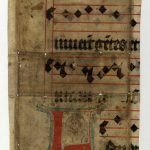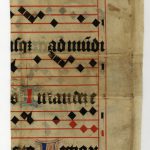Fragment of the Graduale Varadinense. A fragment of the psalm Quare fremuerunt gentes to the introit Dominus dixit ad me was preserved from the first mass of Christmas, followed by the trope Laudem Deo dicam starting the lesson Populus gentium. On the verso the first notes of the two-part (organum style) first line (Lectio Ysaie) of the lecture are transmitted. Although the trope Laudem Deo is not unknown to the liturgical practice of medieval Hungary (its monophonic version can be found in the 14th century Missale Notatum Strigoniense – f. 367r, http://cantus.sk/image/17580 – moreover, its torso was preserved on the 12th-century fragment of a Hungarian troper-proser found in Šibenik, Samostan sv. Frane, Cod. 10, flyleaves with musical notation, see F 990), its two-part version did not occur so far in other Hungarian sources. In her comparative researches, Szendrei highlighted the chant’s German-Silesian parallels (Szendrei, see in the Bibliography).
Zsuzsa Czagány



